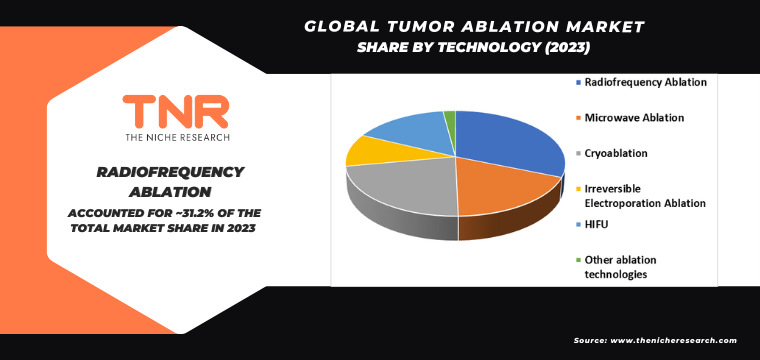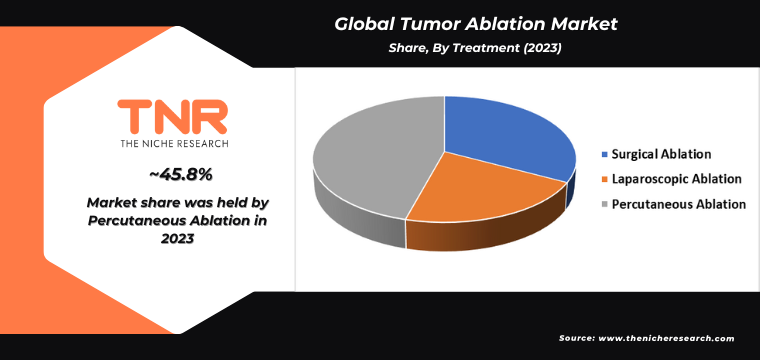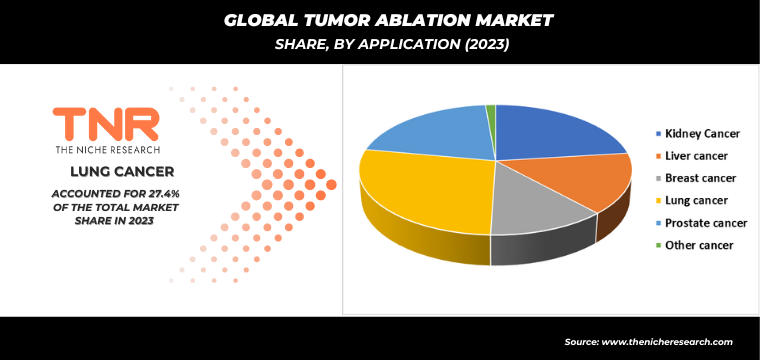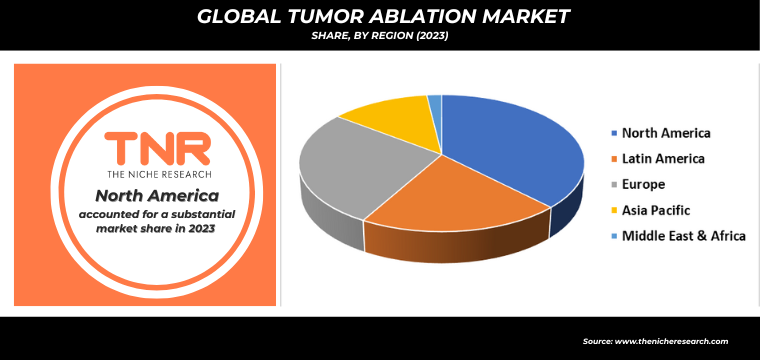Global Tumor Ablation Market: By Technology, By Treatment, By Application, By Region & Segmental Insights Trends and Forecast, 2024 – 2034
- Industry: Healthcare
- Report ID: TNR-110-1154
- Number of Pages: 420
- Table/Charts : Yes
- June, 2024
- Base Year : 2024
- No. of Companies : 10+
- No. of Countries : 29
- Views : 10125
- Covid Impact Covered: Yes
- War Impact Covered: Yes
- Formats : PDF, Excel, PPT
Tumor ablation refers to a minimally invasive medical procedure aimed at destroying cancerous tumors using various energy-based techniques. This approach is typically considered for patients who are unable to undergo surgery or prefer a less invasive treatment option. Common methods of tumor ablation include radiofrequency ablation (RFA), microwave ablation (MWA), and cryoablation. RFA involves using high-frequency electrical currents to generate heat and destroy the tumor tissue, while MWA employs electromagnetic waves to achieve similar results through heating.
Cryoablation, on the other hand, uses extreme cold to freeze and kill cancer cells. These techniques are guided by imaging modalities such as ultrasound, CT scans, or MRI to precisely target the tumor and minimize damage to surrounding healthy tissue. Tumor ablation is often used for tumors in organs like the liver, kidneys, lungs, and bones, offering patients a treatment option that can reduce pain, preserve organ function, and potentially improve overall quality of life.
The demand for tumor ablation procedures is increasingly driven by advancements in technology and a shift towards minimally invasive treatments in oncology. Techniques such as radiofrequency ablation (RFA), microwave ablation (MWA), and cryoablation are gaining prominence due to their effectiveness in treating tumors while minimizing damage to surrounding healthy tissues. These procedures are particularly sought after for patients who are not candidates for surgery or who prefer less invasive options with shorter recovery times. Moreover, the growing incidence of cancer globally, especially in aging populations, underscores the need for innovative treatment approaches that can provide effective outcomes while maintaining patient quality of life.
Additionally, the expanding applications of tumor ablation beyond traditional surgical settings, such as in combination therapies and palliative care, contribute to its increasing adoption. As technological advancements continue to improve the precision and safety of ablation techniques, the demand for these minimally invasive treatments in oncology is expected to rise further.
In terms of revenue, the global tumor ablation market was worth US$ 1.7 Bn in 2023, anticipated to witness CAGR of 14.2% during 2024 – 2034.

Global Tumor Ablation Market Dynamics
Technological Advancements: Rapid innovations in wearable devices, IoT integration, and miniaturization are driving growth by enhancing device capabilities and patient monitoring accuracy.
Aging Population: Increasing elderly demographics globally fuel demand for medical electronics, including vital sign monitors and home healthcare devices, to manage chronic conditions and improve quality of life. Stringent regulations, such as FDA approvals and CE marking, influence market entry and product adoption, ensuring safety and efficacy standards are met.
Telemedicine Expansion: The rise of telehealth and remote patient monitoring amplifies the need for connected medical devices that facilitate remote diagnostics and data transmission, expanding market opportunities. Healthcare cost containment initiatives drive demand for affordable, efficient medical electronics solutions that optimize healthcare delivery and patient outcomes.

Percutaneous Ablation Segment has Garnered Major Market Share in the Global Tumor Ablation Market During the Forecast Period (2024 – 2034).
Percutaneous ablation techniques, including radiofrequency ablation (RFA), microwave ablation (MWA), and cryoablation, are increasingly in demand for treating various types of tumors due to several compelling factors. These minimally invasive procedures offer significant advantages over traditional surgery, such as reduced recovery times, shorter hospital stays, and lower complication rates. They are particularly favored for patients with small tumors or those who are not suitable candidates for surgery due to medical reasons or advanced age.
Percutaneous ablation techniques are versatile and can be applied to tumors in various organs including the liver, kidneys, lungs, and bones, providing a less invasive alternative that preserves surrounding healthy tissue. Advances in imaging technologies, such as CT and ultrasound guidance, have enhanced the precision and safety of these procedures, allowing for more accurate targeting and effective treatment outcomes. As healthcare systems prioritize patient-centered care and cost-effective treatment options, percutaneous ablation continues to gain traction as a valuable therapeutic approach in oncology, driving its increasing adoption and demand globally.

By Application Lung Cancer Segment had the Highest Share in the Global Tumor Ablation Market in 2023.
The demand for tumor ablation techniques in the treatment of lung cancer is notably driven by several key factors specific to this disease and its management. Firstly, lung cancer remains one of the leading causes of cancer-related deaths globally, necessitating effective treatment options that can address both early and advanced stages of the disease. Tumor ablation procedures such as radiofrequency ablation (RFA) and microwave ablation (MWA) offer minimally invasive alternatives to surgery, particularly beneficial for patients who are not surgical candidates or those seeking less invasive treatment options. Secondly, advancements in imaging technology, such as CT-guided and ultrasound-guided ablations, have significantly improved the accuracy and safety of these procedures, enhancing their effectiveness in targeting tumors within the lung tissue.
Additionally, the potential for shorter hospital stays, reduced recovery times, and fewer complications compared to traditional surgical interventions further contributes to the growing adoption of tumor ablation for lung cancer treatment. As research continues to demonstrate favorable outcomes and expanded applications, the demand for tumor ablation in lung cancer management is expected to continue to rise, shaping the landscape of oncological care.

By Region, North America Dominated the Global Tumor Ablation Market in 2023.
In North America, tumor ablation procedures are driven by several factors that contribute to the growing demand for this minimally invasive treatment option. Firstly, the rising incidence of cancer across the region has heightened the need for effective and less invasive treatment alternatives. Tumor ablation techniques, including radiofrequency ablation (RFA), microwave ablation (MWA), and cryoablation, offer patients with localized tumors a viable option that avoids surgery and reduces recovery times.
Secondly, advancements in imaging technologies such as MRI and CT scans have improved the precision and efficacy of tumor ablation procedures, making them more accessible and effective for patients. Additionally, the aging population in North America, coupled with an increasing emphasis on personalized medicine, further drives the adoption of tumor ablation as an option that can be tailored to individual patient needs. As a result, healthcare providers and patients alike are increasingly opting for tumor ablation procedures, positioning it as a significant growth area within the oncology field in North America.

Competitive Landscape: Global Tumor Ablation Market:
- AngioDynamics
- Bioventus Inc.
- Boston Scientific Corporation
- Chongqing Haifu Medical Technology Co., Ltd.
- EDAP TMS
- S. Hospital Service S.p.A.
- HealthTronics, Inc.
- Johnson & Johnson Service Inc.
- Medtronic plc.
- Mermaid Medical
- Other Industry Participants
Global Tumor Ablation Market Scope
| Report Specifications | Details |
| Market Revenue in 2023 | US$ 1.7 Bn |
| Market Size Forecast by 2034 | US$ 7.3 Bn |
| Growth Rate (CAGR) | 14.2% |
| Historic Data | 2016 – 2022 |
| Base Year for Estimation | 2023 |
| Forecast Period | 2024 – 2034 |
| Report Inclusions | Market Size & Estimates, Market Dynamics, Competitive Scenario, Trends, Growth Factors, Market Determinants, Key Investment Segmentation, Product/Service/Solutions Benchmarking |
| Segments Covered | By Technology, By Treatment, By Application, By Region |
| Regions Covered | North America, Europe, Asia Pacific, Middle East & Africa, Latin America |
| Countries Covered | U.S., Canada, Mexico, Rest of North America, France, The UK, Spain, Germany, Italy, Nordic Countries (Denmark, Finland, Iceland, Sweden, Norway), Benelux Union (Belgium, The Netherlands, Luxembourg), Rest of Europe, China, Japan, India, New Zealand, Australia, South Korea, Southeast Asia (Indonesia, Thailand, Malaysia, Singapore, Rest of Southeast Asia), Rest of Asia Pacific, Saudi Arabia, UAE, Egypt, Kuwait, South Africa, Rest of Middle East & Africa, Brazil, Argentina, Rest of Latin America |
| Key Players | AngioDynamics, Bioventus Inc., Boston Scientific Corporation, Chongqing Haifu Medical Technology Co., Ltd., EDAP TMS, H.S. Hospital Service S.p.A., HealthTronics, Inc., Johnson & Johnson Service Inc., Medtronic plc., Mermaid Medical |
| Customization Scope | Customization allows for the inclusion/modification of content pertaining to geographical regions, countries, and specific market segments. |
| Pricing & Procurement Options | Explore purchase options tailored to your specific research requirements |
| Contact Details | Consult With Our Expert
Japan (Toll-Free): +81 663-386-8111 South Korea (Toll-Free): +82-808- 703-126 Saudi Arabia (Toll-Free): +966 800-850-1643 United Kingdom: +44 753-710-5080 United States: +1 302-232-5106 E-mail: askanexpert@thenicheresearch.com
|
Global Tumor Ablation Market
By Technology
- Radiofrequency Ablation
- Microwave Ablation
- Cryoablation
- Irreversible Electroporation Ablation
- HIFU
- Other ablation technologies
By Treatment
- Surgical Ablation
- Laparoscopic Ablation
- Percutaneous Ablation
By Application
- Kidney Cancer
- Liver cancer
- Breast cancer
- Lung cancer
- Prostate cancer
- Other cancer
By Region
- North America (U.S., Canada, Mexico, Rest of North America)
- Europe (France, The UK, Spain, Germany, Italy, Nordic Countries (Denmark, Finland, Iceland, Sweden, Norway), Benelux Union (Belgium, The Netherlands, Luxembourg), Rest of Europe)
- Asia Pacific (China, Japan, India, New Zealand, Australia, South Korea, Southeast Asia (Indonesia, Thailand, Malaysia, Singapore, Rest of Southeast Asia), Rest of Asia Pacific)
- Middle East & Africa (Saudi Arabia, UAE, Egypt, Kuwait, South Africa, Rest of Middle East & Africa)
- Latin America (Brazil, Argentina, Rest of Latin America)
Report Layout:

Table of Contents
Note: This ToC is tentative and can be changed according to the research study conducted during the course of report completion.
**Exclusive for Multi-User and Enterprise User.
Global Tumor Ablation Market
By Technology
- Radiofrequency Ablation
- Microwave Ablation
- Cryoablation
- Irreversible Electroporation Ablation
- HIFU
- Other ablation technologies
By Treatment
- Surgical Ablation
- Laparoscopic Ablation
- Percutaneous Ablation
By Application
- Kidney Cancer
- Liver cancer
- Breast cancer
- Lung cancer
- Prostate cancer
- Other cancer
By Region
- North America (U.S., Canada, Mexico, Rest of North America)
- Europe (France, The UK, Spain, Germany, Italy, Nordic Countries (Denmark, Finland, Iceland, Sweden, Norway), Benelux Union (Belgium, The Netherlands, Luxembourg), Rest of Europe)
- Asia Pacific (China, Japan, India, New Zealand, Australia, South Korea, Southeast Asia (Indonesia, Thailand, Malaysia, Singapore, Rest of Southeast Asia), Rest of Asia Pacific)
- Middle East & Africa (Saudi Arabia, UAE, Egypt, Kuwait, South Africa, Rest of Middle East & Africa)
- Latin America (Brazil, Argentina, Rest of Latin America)
The Niche Research approach encompasses both primary and secondary research methods to provide comprehensive insights. While primary research is the cornerstone of our studies, we also incorporate secondary research sources such as company annual reports, premium industry databases, press releases, industry journals, and white papers.
Within our primary research, we actively engage with various industry stakeholders, conducting paid interviews and surveys. Our meticulous analysis extends to every market participant in major countries, allowing us to thoroughly examine their portfolios, calculate market shares, and segment revenues.
Our data collection primarily focuses on individual countries within our research scope, enabling us to estimate regional market sizes. Typically, we employ a bottom-up approach, meticulously tracking trends in different countries. We analyze growth drivers, constraints, technological innovations, and opportunities for each country, ultimately arriving at regional figures.Our process begins by examining the growth prospects of each country. Building upon these insights, we project growth and trends for the entire region. Finally, we utilize our proprietary model to refine estimations and forecasts.
Our data validation standards are integral to ensuring the reliability and accuracy of our research findings. Here’s a breakdown of our data validation processes and the stakeholders we engage with during our primary research:
- Supply Side Analysis: We initiate a supply side analysis by directly contacting market participants, through telephonic interviews and questionnaires containing both open-ended and close-ended questions. We gather information on their portfolios, segment revenues, developments, and growth strategies.
- Demand Side Analysis: To gain insights into adoption trends and consumer preferences, we reach out to target customers and users (non-vendors). This information forms a vital part of the qualitative analysis section of our reports, covering market dynamics, adoption trends, consumer behavior, spending patterns, and other related aspects.
- Consultant Insights: We tap into the expertise of our partner consultants from around the world to obtain their unique viewpoints and perspectives. Their insights contribute to a well-rounded understanding of the markets under investigation.
- In-House Validation: To ensure data accuracy and reliability, we conduct cross-validation of data points and information through our in-house team of consultants and utilize advanced data modeling tools for thorough verification.
The forecasts we provide are based on a comprehensive assessment of various factors, including:
- Market Trends and Past Performance (Last Five Years): We accurately analyze market trends and performance data from preceding five years to identify historical patterns and understand the market’s evolution.
- Historical Performance and Growth of Market Participants: We assess the historical performance and growth trajectories of key market participants. This analysis provides insights into the competitive landscape and individual company strategies.
- Market Determinants Impact Analysis (Next Eight Years): We conduct a rigorous analysis of the factors that are projected to influence the market over the next eight years. This includes assessing both internal and external determinants that can shape market dynamics.
- Drivers and Challenges for the Forecast Period:Identify the factors expected to drive market growth during the forecast period, as well as the challenges that the industry may face. This analysis aids in deriving an accurate growth rate projection.
- New Acquisitions, Collaborations, or Partnerships: We keep a close watch on any new acquisitions, collaborations, or partnerships within the industry. These developments can have a significant impact on market dynamics and competitiveness.
- Macro and Micro Factors Analysis:A thorough examination of both macro-level factors (e.g., economic trends, regulatory changes) and micro-level factors (e.g., technological advancements, consumer preferences) that may influence the market during the forecast period.
- End-User Sentiment Analysis: To understand the market from the end-user perspective, we conduct sentiment analysis. This involves assessing the sentiment, preferences, and feedback of the end-users, which can provide valuable insights into market trends.
- Perspective of Primary Participants: Insights gathered directly from primary research participants play a crucial role in shaping our forecasts. Their perspectives and experiences provide valuable qualitative data.
- Year-on-Year Growth Trend: We utilize a year-on-year growth trend based on historical market growth and expected future trends. This helps in formulating our growth projections, aligning them with the market’s historical performance.
Research process adopted by TNR involves multiple stages, including data collection, validation, quality checks, and presentation. It’s crucial that the data and information we provide add value to your existing market understanding and expertise. We have also established partnerships with business consulting, research, and survey organizations across regions and globally to collaborate on regional analysis and data validation, ensuring the highest level of accuracy and reliability in our reports.









